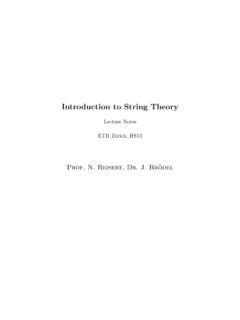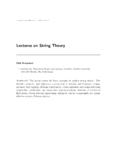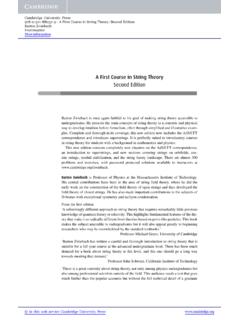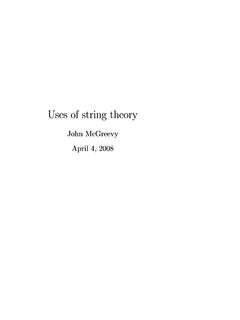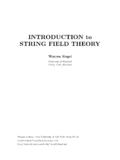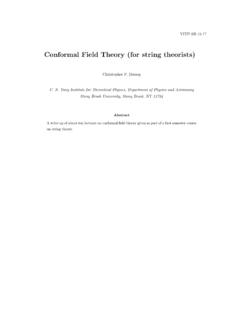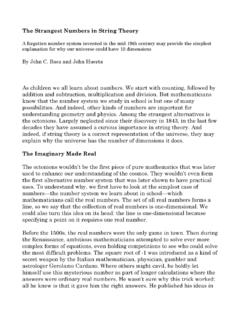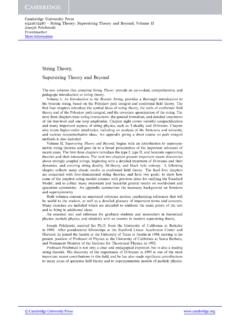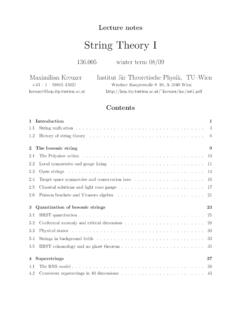Transcription of String Theory 101 - King's College London
1 String Theory 101 Lectures at the International School of Strings and Fundamental PhysicsMunich July 26 - August 6 2010 Neil LambertTheory DivisionCERN1211 Geneva 23 SwitzerlandEmail: Introduction: Why String Theory ?32 Classical and Quantum Dynamics of Point Classical Action .. Electromagnetic field .. Quantization .. 83 Classical and Quantum Dynamics of Classical Action .. Spacetime Symmetries and Conserved Charges .. Quantization .. Open Strings .. Closed Strings .. 274 Light-cone 26, a= 1 .. Partition Function .. 345 Curved Spacetime and an Effective Strings in Curved Spacetime .. A Spacetime Effective Action.
2 386 Type II strings .. Type I and Heterotic String .. The Spacetime Effective Action .. 4621 Introduction: Why String Theory ?The so-called Standard Model of Particle Physics is the most successful scientific theoryof Nature in the sense that no other Theory has such a high level of accuracy over sucha complete range of physical phenomena using such a modest number of assumptionsand parameters. It is unreasonably good and was never intended to be so its formulation around 1970 there has not been a single experimental result thathas produced even the slightest disagreement. Nothing, despite an enormous amount ofeffort. But there are skeletons in the closet.
3 Let me mention just first is the following: Where does the Standard Model come from? For example ithas quite a few parameters which are only fixed by experimental observation. What fixesthese? It postulates a certain spectrum of fundamental particle states but why these? Inparticular these particle states form three families, each of which is a copy of the others,differing only in their masses. Furthermore only the lightest family seems to have muchto do with life in the universe as we know it, so why the repetition? It is somewhatanalogous to Mendelev s periodic table of the elements. There is clearly a discerniblestructure but this wasn t understood until the discovery of quantum mechanics.
4 Weare looking for the underlying principle that gives the somewhat bizarre and apparentlyad hoc structure of the Standard Model. Moreover the Standard Model also doesn tcontain Dark Matter that constitutes most of the stuff in the observable second problem is that, for all its strengths, the Standard Model does not includegravity. For that we must use General Relativity which is a classical Theory and as suchis incompatible with the rules of quantum mechanics. Observationally this is not aproblem since the effect of gravity, at the energy scales which we probe, is smaller bya factor of 10 40than the effects of the subnuclear forces which the Standard Modeldescribes.
5 You can experimentally test this assertion by lifting up a piece of paper withyour little finger. You will see that the electromagnetic forces at work in your littlefinger can easily overcome the gravitational force of the entire earth which acts to pullthe paper to the this is clearly a problem theoretically. We can t claim to understand theuniverse physically until we can provide one Theory which consistently describes gravityand the subnuclear forces. If we do try to include gravity into QFT then we encounterproblems. A serious one is that the result is non-renormalizable, apparently producingan infinite series of divergences which must be subtracted by inventing an infinite seriesof new interactions, thereby removing any predictive power.
6 Thus we cannot use themethods of QFT as a fundamental principle for third problem I want to mention is more technical. Quantum field theoriesgenerically only make mathematical sense if they are viewed as a low energy to the effects of renormalization the Standard Model cannot be valid up to allenergy scales, even if gravity was not a problem. Mathematically we know that theremust be something else which will manifest itself at some higher energy scale. All wecan say is that such new physics must arise before we reach the quantum gravity scale,which is some 1017orders of magnitude above the energy scales that we have tested to3date. To the physicists who developed the Standard Model the surprise is that we havenot already seen such new physics many years ago.
7 And we are all hoping to see it soonat the these comments in mind this course will introduce String Theory , which, for goodor bad, has become the dominant, and arguably only, framework for a complete theoryof all known physical phenomena. As such it is in some sense a course to introduce themodern view of particle physics at its most fundamental level. Whether or not StringTheory is ultimately relevant to our physical universe is unknown, and indeed may neverbe known. However it has provided many deep and powerful ideas. Certainly it has hada profound effect upon pure mathematics. But an important feature of String Theoryis that it naturally includes gravitational and subnuclear-type forces consistently in amanner consistent with quantum mechanics and relativity (as far as anyone knows).
8 Thus it seems fair to say that there is a mathematical framework which is capable ofdescribing all of the physics that we know to be true. This is no small it is also fair to say that no one actually knows what String Theory really any event this course can only attempt to be a modest introduction that is aimed atstudents with no previous knowledge of String Theory . There will be much that we willnot have time to discuss: most notably the Veneziano amplitude, anomaly cancellationand compactification. The reader will undoubtably benefit from the other courses inthe School, in particular the notes of Ralph Blumenhagen on notes are a variation on a course String Theory and Branes (7ccmms34) that I have given at King s College London .
9 You can find the notes here: will first discuss the Bosonic String in some detail. Although this Theory is unphysicalin several ways (it has a tachyon and no Fermions) it is simpler to study than thesuperstring but has all the main ideas built-in. We then add worldsheet Fermions andsupersymmetry to obtain the superstring theories that are used in current research butour discussion will be relatively Classical and Quantum Dynamics of Point Classical ActionWe want to describe a single particle moving in spacetime. For now we simply considerflatD-dimensional Minkowski spaceds2= (dx0)2+ (dx1)2+ (dx2)2+..+ (dxD 1)2( )A particle has no spatial extent but it does trace out a curve - its worldline - in in the absence of external forces this will be a straight line (geodesic if you4know GR).
10 In other words the equation of motion should be that the length of theworldline is extremized. Thus we takeSpp= m ds= m X X d ( )where parameterizes the points along the worldline andX ( ) gives the location of theparticle in spacetime, embedding coordinates of the worldline into us note some features of this action. Firstly it is manifestly invariant underspacetime Lorentz transformationsX X where T = . Secondly it isreparameterization invariant under ( ) for any invertible change of worldlinecoordinated =d d d , X =dX d =d d dX d ( )thusSpp= m dX d dX d d = m (d d )2dX d dX d d d d = m dX d dX d d ( )Thirdly we can see why themappears in front and with a minus sign by looking at thenon-relativistic limit.



